from
http://www.soundandvision.com/content/february-2017-new-gear
Solar-powered homes conjure images of huge panels across roofs and homeowners writing checks of exorbitant amounts to pay for it all. No doubt, it’s a huge investment in time, money, and the design of a home. Thanks to a new technology being developed and son released by SolPad, you can harness the energy of the sun to power devices in your home for less than $1,500. Plus, it’s portable, so you can integrate into your home environment or take it with you for off-grid applications.
What’s really novel, however, is the ability to personalize the management and delivery of the solar power the SolPad Mobile generates. Using SolPad’s SolControl software, you can choose to send solar power to specific devices and the best time to use the solar power for maximum utility bill savings. This customization all happens via iPhone. SolPad mobile communicates and sends energy to devices that are connected to a SolControl smart plug, which plugs into a standard AC outlet.
SolPad Mobile combines 70 watts of solar generation, 600 Wh battery storage, two USB charging outlets, Wi-Fi, and artificial intelligence. Its two universal outlets can output 2,000 watts of peak power and 1,000 watts continuous.
Beginning May 3, SolPad Mobile can be preordered for $1,395. A limited-offer SolPad will include for free the SolControl Solar Smart Plug (valued at $59.95). Additional SolControls are available for $39.95.
The post Portable Solar Panel Powers Appliances You Select appeared first on Electronic House.
Swimming may be the last thing on the minds of people in cold winter climates, but it’s never too early to start making plans for the summer. And while swimming pools are fun to have in a back yard, they also require a fair amount of work to maintain. A new system from ConnectedYard feeds data about the water conditions of your pool over the Internet to your smartphone 24/7, minimizing the chance of under- or over-treating it with chemicals. You can get real time, on the spot reports of the pH, chlorine, alkalinity, hardness, and cyanuric acid levels.
Floating Bluetooth and Wi-Fi enabled sensors monitor the chemical makeup of the swimming pool and/or hot tub water and send it to a mobile app. The same app can be used to order chemicals and seek advice and schedule cleaning and winterizing, etc. from a pHin network of retailers (a subscription to the service is required). The subscription price also includes the monitor, the mobile app, and basic chemicals for 12 months—ConnectedYard says the price is about the same as you pay today for the chemicals alone.
The pHin subscription starts at $269 a year. There are two types of membership: an annual membership that runs for 12 months and a seasonal membership for 4 months for those who drain or winterize their pool during the off-season.
The post Hassle-free Swimming Pool Monitoring System appeared first on Electronic House.
Technology comes in all shapes and forms, and the three finalists of this year’s Extreme Tech Challenge will pitch their ventures one last time to Sir Richard Branson along with a high-caliber panel of judges in hopes of gaining investment for their budding enterprise. Having edged past 25 other competitors from around the globe, the 2017 Extreme Tech Challenge Finalists represent a diverse breadth of industries: hemostatic solution from Cresilon (New York, N.Y.), filament recycling ReDecTec (Toronto), and high-tech aerial camera specialists Vantage Robotics (San Francisco, Calif.)
The final judging takes place February 2 on Necker Island, the culmination of selection process that began several months ago, including a highly-contested semi-finals round at CES 2017 in January.
Of the three finalists, Vantage Robotics offers a technology that could impact the smart home market in some very interesting ways. The company’s 4K flying camera could be described as a drone, one of the biggest growth areas at CES 2017, and a technology that is starting to be used as a flying security sensor that can enable homeowners to visually monitor their home and property. In addition to home security purposes, drones are also being developed as a way for realtors and home builders to capture bird-eye views of their properties to share with potential clients. Then there are the purely recreational reasons for investing in a drone: action photography, social media, and simply being able to control a flying contraption from your smartphone.
Vantage’s Snap can support of these applications, but with a few extra twists. For starters, the integrated Sony Exmor IMX 377 1/ 2.3” camera sensor captures images in 4K. These can be streamed right to your smartphone. Your phone also guides the Snap in a super easy way: Just hold your phone up while the Snap is flying, tap on the aerial images where you want Snap to go, and send it on its way. During its travels, the Snaps remarkable number of sensors ensures that it reaches its destination safely and is able to provide the best bird’s eye view possible. Vantage Robotics squeezed in GPS, sonar, gyros, accelerometers, magnetometers, barometers, and geo-aware images sensors. They fused all the data gathered by the sensors with lots of math so that Snap always knows where it is, where you are, and lets you stay in complete control. The company also designed the whirling blades to be extremely safe. We check out the Vantage Robotics’ website for pricing info: The Snap currently sells for $915.
The two other finalists may not be associated with the smart home industry, but here’s a brief synopsis of each entry:
Redefining the way military, first responders, and doctors handle medical emergencies, Cresilon is a plant-based hemostatic gel that accelerates the natural blood clotting process.
Producer of a desktop filament extruder and recycling unit for 3D printers, ReDeTec creates novel plastic processing technology with reduced energy and space requirement. This frees up plastic recycling from the factory floor, making it a much more accessible technology for everyone.
The post XCT 2017 Finalists: Most Innovative Technology to be Chosen at Richard Branson’s Private Island appeared first on Electronic House.

It’s always good to have options, and Cary Audio ensures that no matter how you like to derive music, its AiOS (All-In-One-System) music player will support it. Like many media players on the market, the AiOS can connect to your home network via Wi-Fi or Ethernet to stream digital music files that are stored on computers and NAS drives. The connection also enables streaming of Internet music services like Spotify and Tidal.
If you feel more comfortable just popping in a USB flash drive or SD card that carries your music, the AiOS has slots for those, too. And no matter what source you choose to listen to, the AiOS can send the music to Bluetooth enabled speakers and headphones for a completely wireless setup.
Additionally, the AiOS includes multiple analog and digital inputs and outputs, including a subwoofer output and preamplifier output.
It’s a common practice to hide A/V components, but the AiOS bucks that trend by integrating several decorative features. It’s comes with standard gunmetal gray side panels, but these can be swapped (for an additional charge) for spring green, deep plum, Cary blue, candy red, and champagne gold panels. Plus, with the touch of a button the AiOS can change its backlit keys/buttons and center LCD (together of separately) to six different preset colors, including one custom color preset or adjust any color as you see fit.
The AiOS measures 3.0 inches high, 14.2 inches wide, and 11 inches deep, and retails for $2,995.
The post Cary Audio Streaming Media Player Offers Bountiful Music Listening Options appeared first on Electronic House.
After sustaining a neck injury and retiring from the NFL’s Green Bay Packers at the age of 28, All-American Safety Nick Collins returned to his home state of Florida with his wife and children to begin the next stage of his career as a personal trainer.
When Nick and Andrea Collins began building their all-new 10,000-square foot ranch in Winter Garden, they knew wanted to be able to control their home’s lighting, security, climate, audio and video systems with the touch of a button and regardless of their physical location inside the sprawling new home.
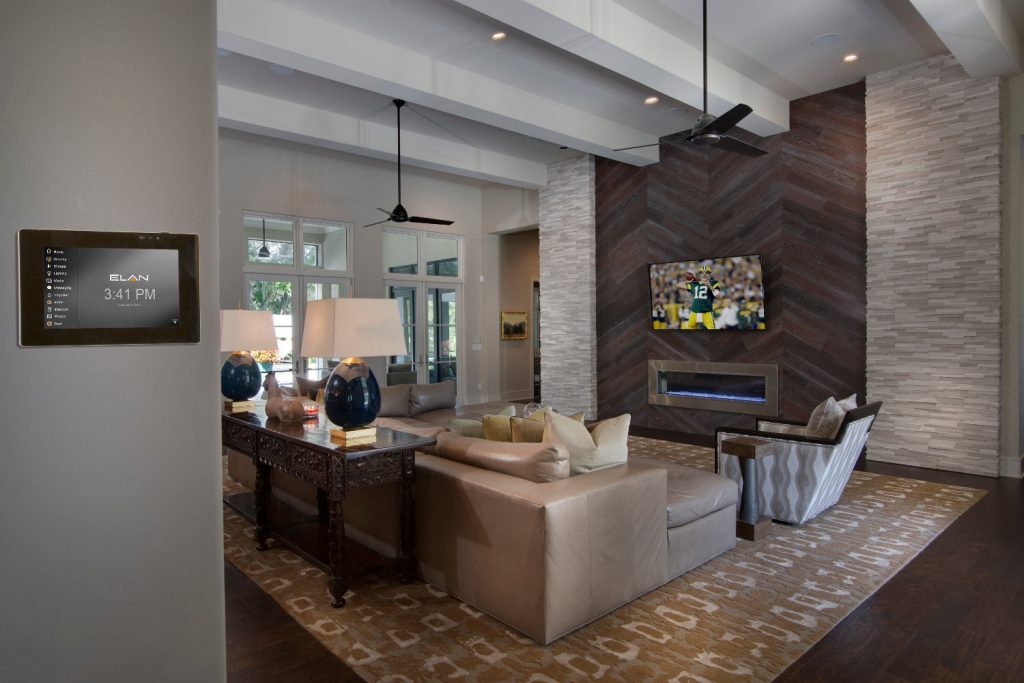
To make this dream a reality, they turned to local technology integrator Mike Barry of Millennium Systems Design, who they had worked with in the past on a previous home.
“The Collins family needed total home control in the simplest way possible,” says Barry. “I knew that the ELAN Entertainment and Control System would offer secure and instant remote control that could be relied upon for years to come as they went about their busy schedule.”
With Nick and Andrea’s go-ahead on the game-plan, Millennium Systems Design installed an ELAN gSC10 System Controller, three ELAN g1 Systems Controllers, and two ELAN S1616A Multi-Room Audio Amplifiers to span the entire home.
To provide easy, convenient control of the system, Millennium Systems Design installed 10 ELAN in-wall touch panels and connected three ELAN remotes, and with the ELAN mobile app Nick and Andrea can control any technology within the home from anywhere in the world.



“We love having a touch panel in every room of the house,” says Collins. “Regardless of what room I am in, I can adjust anything I need to, whether it be the music playing or the lighting levels. Even when I am out training, I can check in on the security camera footage from the ELAN App on my phone.”
With five children living in the single-floored ranch, the Collins family also required simple face-to-face communications enabled by the system. ELAN’s Intercom feature, Andrea Collins adds, is an extremely useful tool that the family can use to communicate throughout the house.
“I can call the kids from the living room using the ELAN touchpanel and it’s so much easier than yelling!” she remarks.
 High-end audio was also a crucial component of the family’s new smart home. To build an extensive audio system that would allow Nick and Andrea to listen to whatever they wanted in any room of the house, Millennium Systems Design divided the extensive system into 19 different zones of audio.
High-end audio was also a crucial component of the family’s new smart home. To build an extensive audio system that would allow Nick and Andrea to listen to whatever they wanted in any room of the house, Millennium Systems Design divided the extensive system into 19 different zones of audio.
“Every single room has its own audio zone, and each can be controlled through the home control system,” says Barry. “It’s one of the biggest audio systems I have ever built.”
To ensure that the audio was felt and heard, Millennium Systems Design installed SpeakerCraft Profile Cinema in-ceiling subwoofers to produce targeted sound in the large spaces, like the Grand Hall.
“The whole home audio system is hidden but heard,” says Barry. “For example, to fill the outside courtyard with quality sound, I installed multiple SpeakerCraft RUCUKUS 6 One rock speakers that blend right into the landscape. The speakers look subtle, but they don’t sound subtle.”
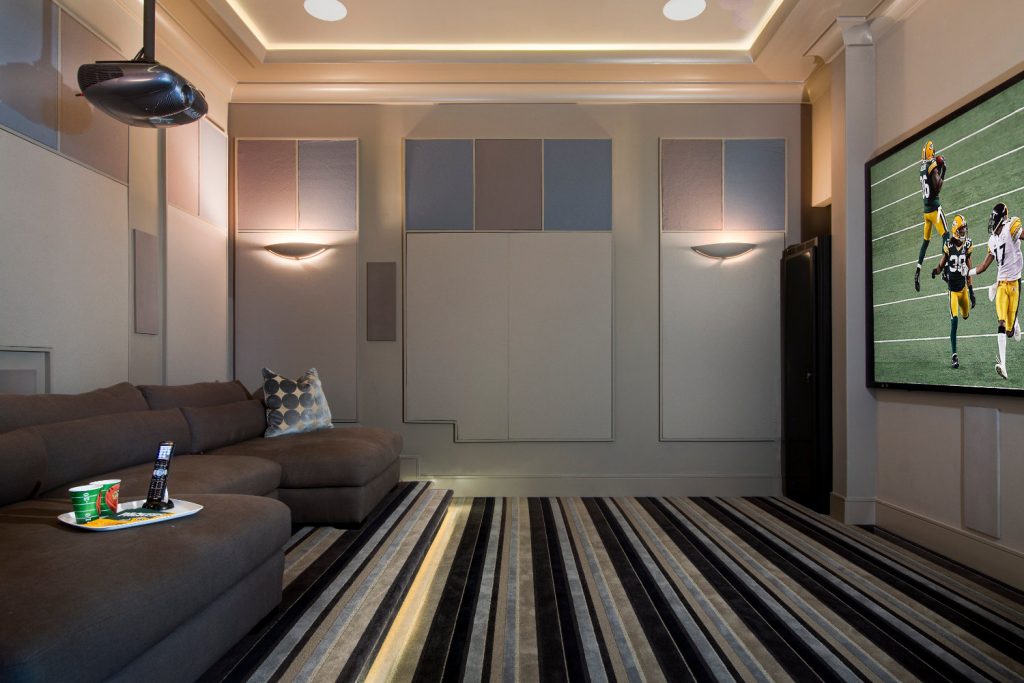 Additionally, the Collins’ home theater has its own standalone Dolby Atmos audio system that is also controlled through the ELAN App.
Additionally, the Collins’ home theater has its own standalone Dolby Atmos audio system that is also controlled through the ELAN App.
Creating an environment that embodies a cinema-like experience, Millennium Systems Design installed a Stewart Filmscreen Luxus Deluxe 123″ 16:9 Soundscreen paired with a SIM2 projector that can play films and video games in 3D.
Additionally, Millennium Systems Design installed six reclining theater chairs, which can also be controlled via the ELAN app, with three big bean bag chairs for the kids.
“We often host movie nights with our family and friends,” says Collins. “We pop in any movie we want, right at home. I also play video games with the kids in the theater, which is really awesome.”



Because Winter Garden experiences a fair share of thunderstorms, Millennium Systems Design made sure to protect all of the home’s technology with a Panamax M4320-Pro power conditioner.
“Power protection is extremely important,” says Barry. “The BlueBOLT remote energy management in the M4320-Pro makes it really easy to reset the network after a storm. I get a notification in my office and I can easily reset the Wi-Fi, cable boxes, and more.”
According to Barry, the home is in an isolated area at the end of a power line, so they get some ‘dirty power’ coming into their house that may result in some of the devices acting ‘spotty’ or faulty.
“Through Panamax, we were able to clean up that power to ensure a better performance for their devices,” adds Barry. “With this much high-end technology, it’d be a shame if they didn’t work correctly just because of the power grid.”
Nick and Andrea are incredibly happy with their smart home.
“This system is basic but sophisticated; we really like that,” says Collins. “We use it every single day. There is so much you can do with ELAN, it’s like an open book that we can keep adding to.”
The post Inside NFL Green Bay Packers Hall-of-Famer Nick Collins’ Smart Home appeared first on Electronic House.
The Internet of Things (IoT) is already connecting millions of formerly unconnected “things” to the Internet, allowing homeowners to more easily monitor and control devices like thermostats, light switches, surveillance cameras, and garage door openers and more. It a huge convenience and time-saver, but at the same time, it poses a potential threat of cyber hacking. When information is shared across the Internet, it can fall into the wrong hands, leaving your home and belongings at risk. According to Cisco Systems, in 2008 there were already more things connected to the Internet than people, and that number is expected to explode, reaching 50 billion devices by 2020.
 With each new Internet-connected device that enters your home, you add another avenue for cyber attacks. For this reason, companies like BullGuard have been hard at work developing security solutions to detect and protect all smart home devices from cyber threats, ultimately safeguarding important data and your privacy.
With each new Internet-connected device that enters your home, you add another avenue for cyber attacks. For this reason, companies like BullGuard have been hard at work developing security solutions to detect and protect all smart home devices from cyber threats, ultimately safeguarding important data and your privacy.
Recently acquired by Dojo Labs, BullGuard has developed a $199 smart home security solution that discovers devices connected to the home network, secures them, and continuously analyzes their network activity for any suspicious behavior.
The Dojo system consists of a “pebble” that sits out where you can see it and is portable; it’s companion dock stays tucked away with your home network’s router. Rings of light on the Dojo pebble illuminate red, yellow, or green when activity is detected on the network.
 A smartphone app allows users to interact with the Dojo pebble to block network activity if necessary.
A smartphone app allows users to interact with the Dojo pebble to block network activity if necessary.
There is also a cloud-based component to the system. This intelligent defense system in the sky gets to know your devices and finds patterns in their behavior. Using this information, it then sets up a perimeter that protects your home and makes sure that you are in total control.
“Most people don’t consider a security solution until after their information has been hacked and their privacy violated. The smart home market is growing at an fast pace, and we’ve recently seen major privacy breaches caused by compromised devices, including the largest ever Distributed Denial of Service (DDOS) attached launched from an IoT botnet,” says Yossi Atias, general manager IoT Security of BullGuard. “Dojo by BullGuard makes it easy to safeguard and protect your privacy and your family by constantly and seamlessly monitoring and protection all smart home devices against security breaches.”
The system will be available in April; the $199 price includes 12 months of service.
The post Prevent Cyber Threats with Dojo by BullGuard System appeared first on Electronic House.
Super Bowl LI is right around the corner, and whether you’ll be cheering on the Falcons or the Patriots, or just plowing through a platter of nachos, it’s the one day of the year when your home entertainment system should look and sound its very best. The colors on the screen should pop, the audio should be clear and powerful, and you should be able to sit back with your family and friends and soak in all the game day action without having to fuss with a bunch of gear.
There are many simple tweaks you can make and components you can add to your viewing location to make the experience more engaging. We asked several home systems integrators to offer their recommendations on how to take your Super Bowl party up a notch. Here’s what they said:
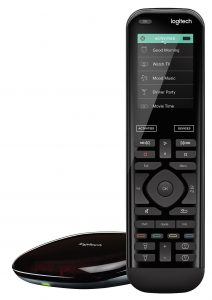 Buy a better remote: Why peck at a slew of buttons on a remote control to get your system up and running when you can tap just one key and make the entire room come to life? If you don’t already own a universal remote control, get one now; if you already have one, consider upgrading to a system that lets you also operate the lights, thermostats, and other devices so that the entire room is under your command.
Buy a better remote: Why peck at a slew of buttons on a remote control to get your system up and running when you can tap just one key and make the entire room come to life? If you don’t already own a universal remote control, get one now; if you already have one, consider upgrading to a system that lets you also operate the lights, thermostats, and other devices so that the entire room is under your command.
The Harmony Elite from Logitech, for example, unifies the control of every component in your entertainment system as well as a growing library of smart home devices (more than 270,000). Imagine unlocking the electronic lock on your front door (yes, it might be an addition worth making prior to the game) by tapping a button on the remote as you settle into your seat. It’s possible. You can even create a special button, called Super Bowl, that fires up the TV, cable box, and surround sound system, adjusts the room lights and lowers the motorized shades.
The Harmony Elite and its companion hub retails for around $349.
Add a Second TV: You pick the spot; you choose the TV. Maybe it’s a 27-inch HD set in the kitchen or 42-inch wall-mounted beauty in the den; perhaps you live in a climate where you can place a weatherproof display outdoors. Whatever the case, a second TV ensures that you and your guests can stay on top of the game day plays while grabbing a drink out of the fridge or getting a breath of fresh air. All you need to add is a product like the Wireless HD Digital Kit ($249.95) from IOGEAR to transmit HD video and 5.1 surround sound wirelessly to a second TV. Seriously consider integrating external speakers; those puny speakers built into the TV likely won’t provide the punch you’re looking for—especially during the Super Bowl. A soundbar (see below) could be a good option.
Install a Video Projector: Maybe you’ve been thinking about trading in your TV for a video projector and screen.  With the price of a 65-inch LED 4K Ultra HD TV running close to $1,000, a separate projector and screen becomes an attractive, financially feasible alternative. For a little extra money, you can enjoy a much larger image. Epson’s Home Cinema 3100, for example, retails for $1,299, and can cast an image measuring 110 inches diagonally that maintains its brightness and clarity in a well-lit room. Pair it with a projection screen, like the DIY Wall 2 screen from Elite Screens, and you’re still well under $1,500.
With the price of a 65-inch LED 4K Ultra HD TV running close to $1,000, a separate projector and screen becomes an attractive, financially feasible alternative. For a little extra money, you can enjoy a much larger image. Epson’s Home Cinema 3100, for example, retails for $1,299, and can cast an image measuring 110 inches diagonally that maintains its brightness and clarity in a well-lit room. Pair it with a projection screen, like the DIY Wall 2 screen from Elite Screens, and you’re still well under $1,500.
Tip: It’s important to think about how far from the screen your guests will be sitting in relation to your screen size. Check out this throw distance calculator from Projector Central to determine how much throw distance you will need.
 Squeeze in a Soundbar: If you’re still using the speakers built into your TV, now’s the time to stop. One of the quickest ways to introduce surround sound into your Super Bowl viewing space is by mounting a soundbar like the PLAYBAR from Sonos to the bottom of your TV—you can always place it on a table below the TV if you don’t feel like mounting it. Add a wireless subwoofer–the Sonos SUB pair nicely with the PLAYBAR—and all those tackles on the football field will sound as if they’re happening right in your living room. The PLAYBAR and SUB each retail for $699.
Squeeze in a Soundbar: If you’re still using the speakers built into your TV, now’s the time to stop. One of the quickest ways to introduce surround sound into your Super Bowl viewing space is by mounting a soundbar like the PLAYBAR from Sonos to the bottom of your TV—you can always place it on a table below the TV if you don’t feel like mounting it. Add a wireless subwoofer–the Sonos SUB pair nicely with the PLAYBAR—and all those tackles on the football field will sound as if they’re happening right in your living room. The PLAYBAR and SUB each retail for $699.
Add More Speakers. What’s great about the PLAYBAR is that it’s designed to stream audio wirelessly to other speakers, which on game day is important for people who want to follow the commentary while they take a breather in kitchen, bathroom, or anywhere else. You can pick up additional Sonos speakers for about $200.
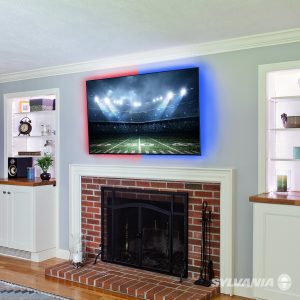 Screw In (Color-Changing) Light Bulbs: Here’s a super-simple way to incorporate team colors into your Super Bowl touchdown celebrations. Color-changing LED bulbs install just like a regular light bulb, cost less than $50, and can be controlled right from your smartphone. When the Patriots score tap on blue and white; when the Falcons rule, switch to red. With seemingly endless color choices and the ability to have the lights strobe on and off at predetermined times, you can create a festive football atmosphere in an instant. The least expensive route is to choose a controllable colored LED bulb that requires no gateway, like Sylvania’s Smart Multicolor A19 bulbs–to receive your smartphone issued commands. After game day is over, the lights can be set back to their everyday color—until next season or your next party.
Screw In (Color-Changing) Light Bulbs: Here’s a super-simple way to incorporate team colors into your Super Bowl touchdown celebrations. Color-changing LED bulbs install just like a regular light bulb, cost less than $50, and can be controlled right from your smartphone. When the Patriots score tap on blue and white; when the Falcons rule, switch to red. With seemingly endless color choices and the ability to have the lights strobe on and off at predetermined times, you can create a festive football atmosphere in an instant. The least expensive route is to choose a controllable colored LED bulb that requires no gateway, like Sylvania’s Smart Multicolor A19 bulbs–to receive your smartphone issued commands. After game day is over, the lights can be set back to their everyday color—until next season or your next party.
Thanks to the following home systems integrators for their input:
David Huse, Theater Advice
Tod Puma, The Source Home Theater
Dan Paulson, Paulson’s Audio & Video
The post Super Bowl 2017: 6 Tips to Improve Your Entertainment System for Big Game appeared first on Electronic House.

There has been an onslaught of devices introduced in the past few months that can be controlled via voice through Amazon Alexa and Google Assistant technology. VIZIO joined the club by announcing that its SmartCast devices including TVs, displays, soundbars and speakers are now compatible with Google Home, Google’s voice-activated speaker powered by the Google Assistant.
With Chromecast built-in, VIZIO SmartCast devices allow Google Home users to use their voice to control their entertainment. Using simple voice commands, Google Home users can adjust volume up and down, play, stop and skip music tracks on any Google Home supported services. Google Home users can even power on their displays by asking to play entertainment on the big screen when the “Quick Start Power Mode” function is enabled on their VIZIO SmartCast TV/display.
To hear a song on their VIZIO SmartCast speaker or sound bar, users can just say, “Ok Google” followed by their song request from Google Play Music, Pandora, Spotify and more. If the “Quick Start Power Mode” feature is enabled on their VIZIO SmartCast TV/display, Google Home users can tell their display to play a movie even when the display is off. The display will then power on and begin loading the requested content from apps like Netflix and YouTube.
“Controlling VIZIO SmartCast devices from Google Home is a significant milestone for consumers and their ability to manage their entertainment experience,” says Matt McRae, chief technology officer, VIZIO. “Using a simple voice command to stream a movie from Netflix to a VIZIO display or stream music from Spotify to a group of VIZIO speakers is an eye-opening experience and shows off the power of VIZIO SmartCast.”
Launched this past year, VIZIO SmartCast is the brand’s newest ecosystem of connected entertainment products, delivering a new way to discover and access content throughout the home. With Chromecast built-in, every VIZIO SmartCast display, soundbar and speaker makes it easy to stream from thousands of mobile apps directly to a VIZIO SmartCast device. By simply tapping the Cast button from within a favorite app like Netflix and YouTube, content is then streamed directly from the Internet to any VIZIO SmartCast device via the respective Wi-Fi network.
The VIZIO SmartCast app can also be used to transform an iOS or Android mobile devices into a powerful touchscreen remote to fully control VIZIO SmartCast devices, as well as use text or voice search to seamlessly search and browse content across multiple apps at once.
The post VIZIO Adds Google Home Control to its SmartCast TVs appeared first on Electronic House.
HDMI (High Definition Multimedia Interface) has been connecting our TVs Blu-ray Disc players, media streamers, soundbars, and other entertainment gear for some time. The cable and connectors have been doing a good job, delivering us clear, engaging audio and video for a top-notch entertainment experience. But as is the case with all things technology related, there’s always room for improvement and always another better, faster, higher performing iteration right around the corner.
HDMI is no exception. Recently, the HDMI Forum, Inc. announced that it has improved upon the HDMI 2.0 specification that’s found on lots of equipment today with the development of a 2.1 version of HDMI. The upcoming release of Version 2.1 of the HDMI Specification not only handles 4K resolution at a 60Hz refresh rate needed for High Dynamic Range (HDR), but goes well beyond that bandwidth need. Its bandwidth handling jumps from 18Gbps found in HDMI 2.0 to 48Gbps, and will be able to carry resolutions up to 10K and frame rates at 120Hz (also 8K at 60Hz and 4K at 120Hz).
The new HDMI 2.1 Spec, which expected to be ready for manufacturers to implement into A/V products and cables in late spring, is basically creates a bigger pipe that is able to handle bigger resolutions and faster frame rates.
Another noteworthy enhancement HDMI 2.1 brings is the support of Dynamic HDR, not just plain old HDR. Dynamic HDR means that metadata can be passed for HDR content on a scene-by scene or even frame-by-frame basis instead of how the current version handles it on a per program basis. In other words, in regular HDR, or HDR10, the metadata is used to improve the picture quality of a program as whole; in Dynamic HDR, the metadata is used continuously, scene by scene, to improve the picture.
“We have no clear understanding of when products will be out. Many of the HDMI Forum members have an early look at the spec so they may be working on products already.”
— Chris Pasqualino, HDMI Forum Chairman
All of this sounds amazing, but don’t let this future benefits stall your plans to buy a new TV until HDMI 2.1 versions come out in 2018 (at least that’s the plan). Know that it will be years before we will see 8K or 10K content for HDMI 2.1 to even use. It took seemingly forever for 4K content to become available even after 4K TV and HDMI 2.0 had hit the marketplace. HDMI 2.1 will likely follow a similar path: TVs and other gear might be equipped with HDMI 2.1 connectors, and HDMI 2.1 cable might be available next year, but there won’t be any content to take advantage of the bigger bandwidth.
Still, it never hurts to know where home entertainment is headed. “This new release of the specification offers a broad range of advanced features for enhancing the consumer entertainment experience, as well as providing robust solutions to the commercial A/V sector,” says Robert Blanchard of Sony Electronics, president of the HDMI Forum.
Also know that HDMI 2.1 connectors and cables will look exactly like HDMI 2.0 cables and connectors and that the spec is backwards compatible. This means that you can connect any player that’s based on HDMI 2.0 to a TVs that’s HDMI 2.1.
Great Features of HDMI 2.1 in a nutshell:
The post HDMI 2.1: Is it Time to Upgrade to Better Cable and TV? appeared first on Electronic House.
Each year, Electronic House’s sister publication CEPro holds in conjunction with the Consumer Technology Associaton (CTA) its Mark of Excellence Awards program. Presented in an evening ceremony at the Venetian Hotel in Las Vegas during CES 2017, the Mark of Excellence Awards recognize some of the best residential and commercial custom installation projects performed by professional integrators, as well as top consumer technology products and services that are primarily sold to and installed for consumers by custom integrators.
The 157 entries, in categories including audio, video, home control, home security, home lighting, and more, were judged by an independent panel of industry experts. Here are the winners in the home audio category:
$249 and $499 each
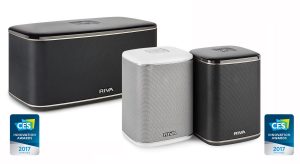
The RIVA ARENA and FESTIVAL are compact wireless speaker in RIVA’s multi-room WAND series of products. It is designed with an open architecture, offering you a wide range of configuration options. For example, music can be streamed to one speaker or up to 32 networked speakers. A host of connectivity technologies are supported, as well, including Wi-Fi, DDMS, Spotify Connect, AirPlay, DLNA, and Bluetooth. As another perk, Google Chromecast is built in.
The speaker employs special technology for three discrete audio channels to create stereophonic sound; unlike most wireless speakers, which are usually mono or quasi-stereo.
One or more ARENAs and FESTIVALs can be operated from the WAND app on a smartphone or tablet. You can configure your speaker network and send music streams to an individual speakers or groups of speakers.
$399.99
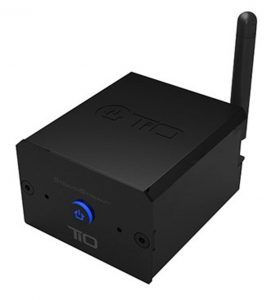
The StealthStream 1 (AZSS1) is a digital audio player that provides users with easy access to a number of music services, including TuneIn, Sirius XM, Tidal, Rhapsody, Deezer, and Spotify. Additionally, a TV, satellite receiver, DVD player, or other component can be connected to the StealthStream 1 so you can hear audio in one room or the entire house. The palm-size StealthStream 1 is portable or it can be installed into a standard one-gang wallbox. Although it’s small it still manages to integrate a 100-watt amplifier.
Up to three SS1s can be networked wirelessly or with wire, and operated via a smartphone/tablet app.
$1,249.99
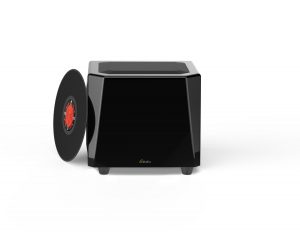
The SuperSub X subwoofer incorporates a newly patented 360-degree dual-plane, inertially balanced driver and sub-bass radiator topology and a 1,400-watt amplifier. Its enclosure is braced in order to eliminate the possibility of resonances and vibrations, or flexing of the cabinet panels due to internal pressure. This force cancelling and inertial balancing preserves and focuses the energy produced by the transducers to effectively move air in the room.
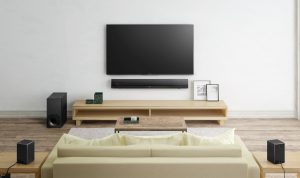
$799.99
The HT-NT5 Sound Bar boasts high-resolution audio playback, and supports both 4K and High Dynamic Range (HDR) content from major movie studios via HDMI HDCP 2.2. This means 4K content can be displays on a 4K TV/projector without any compromise of picture quality. Dolby TrueHD and DTS-HD Master audio formats are also supported. Thanksto Google Cast built inn, you stream songs from music apps including Google Play Music, Spotify Connect, and Pandora directly from your mobile device to the soundbar. Wireless speakers and subwoofers can be added to create a surround-sound experience. With three HDMI inputs, one HDMI ARC output, a USB input and digital optical and analog connectors, the sound bar can accommodate a variety of different A/V equipment.
$1,749 each
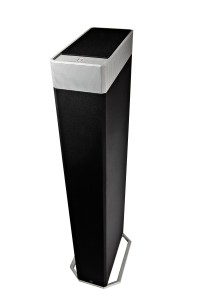
Standing 4.5-feet tall, the BP9080X is a two-channel bipolar speaker that supports Dolby Atmos and DTS:X. Its drivers fire into the room from five sides, producing sound that is bigger, more spacious and provides a more verbose sonic fingerprint than other speakers.
Behind the speaker’s acoustically transparent 360-degree grille, is a tonally inert, resonance-free one-piece cabinet construction featuring front and rear-facing drivers and tweeters, a side firing 12-inch powered subwoofer, and dual bass radiators all working in harmony to produce powerful sound.
$349
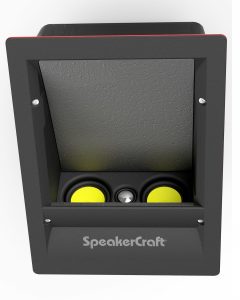
The AIM Series 2 ATX100 is the industry’s first in-wall height speaker designed specifically for Dolby Atmos and other object-based sound formats. The speaker reflects sound off of the ceiling to place and move audio anywhere in the room, adding greater dimension and realism to the movie action. It fits in between 2×4 wall joists.
To maximize sound reproduction and minimize sound transmission to adjacent rooms, the ATX100 features a fully integrated back box. The back box also decouples the speakers from surrounding surfaces so that you hear more of the actual speaker and less of the sound that normally radiates from the mounting surface.
$2,700
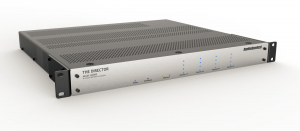
The Director Model M4800 amplifier is designed to amplify audio for a whole-house music system. Audio from as many as 8 components can be amplified for delivery to as many as 64 listening zones, at an output of 100 watts/8-ohms, 200 watts/4-ohms.
Because the audio signature of each listening zone differs, due to layout, furnishings and materials, The Director Model M4800 was designed with advanced DSP settings to deliver properly balanced sound from your favorite speakers to each zone. Whether you enjoy programming from streaming services like Spotify or the finest high-resolution digital recordings, The Director Model 4800 will present the music gracefully. As a bonus, it has been engineered to work seamlessly in a standalone whole-house audio system or as part of a larger home automation system.
The post 7 Award-Winning Home Audio Products appeared first on Electronic House.